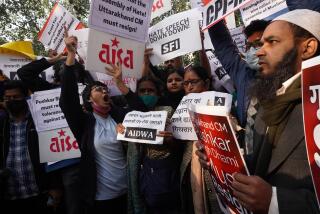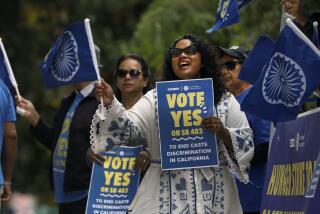India’s Rigid Caste System Slowly Bending to Campaigns to End It : Discrimination: Although some progress is being made, challengers of tradition often face upper-caste revenge.
- Share via
BELAUR, India — India’s feudal caste system is so powerful in this farming village that even a militant group fighting it cannot fully resist complying with it.
Last summer, for the first time anyone could remember in Belaur, a lower-caste person challenged the age-old social system, which determines a villager’s job and where he is allowed to live, sit, worship and drink water.
The shopkeeper refused to sell cigarettes to an upper-caste teen-ager. The refusal resulted in a brawl with multiple injuries, a kidnaping, five killings and the flight of most lower-caste people from Belaur.
Caste divisions are so strong in the village that even the Naxalites, a Maoist guerrilla group helping landless people and bonded laborers, felt obliged to set up two refugee camps. One isolates Mushars, or “Rat Eaters,” a subcaste that even other low-caste people avoid.
Across India, the caste system is being challenged by communist militants and populist political parties and undermined by affirmative action and urban industrialization. That is allowing some lower-caste people to begin fighting their way up the ladder.
But people who challenge the system often face upper-caste revenge, especially in rural areas where everyone knows his neighbors and their caste. The conflict often ends up preserving the social hierarchy that has been ingrained in the Indian consciousness for three centuries.
In some areas of northern India--the Hindi belt where the caste system remains strong--lower castes are trying to emerge as a political and economic force, challenging age-old injustices.
In Uttar Pradesh, India’s most populous state, an election brought a lower-caste coalition to power 14 months ago.
The new government soon enraged upper-caste people by freeing Phoolan Devi, a jailed lower-caste woman known as the “Bandit Queen” for leading her comrades across the state on horseback and allegedly gunning down landowners.
Encouraged by ambitious job and education quota systems for lower castes, northern Indians who once were relegated to poverty and humiliation are beginning to acquire property, raise their incomes and move into the nation’s swelling middle class.
Economic reforms are helping that slow transition, spurring industrialization that is creating new job opportunities.
But lower-caste liberation often leads to clashes, especially in major states such as Bihar, where Belaur is located, and in Uttar Pradesh and Maharashtra. For example, there has been an increase in reported rapes and murders of lower-caste women by upper-caste men across northern India.
Caste consciousness is less strong in the cities, but about 70% of India’s 900 million people live in villages.
In places like Belaur, lower-caste people often have to live in secluded huts and toil for subsistence wages on farms of upper-caste neighbors. They are forbidden to enter the local Hindu temple or drink from wells used by the upper castes.
At mixed-caste gatherings, they sit on the ground. The village headman, usually a member of the upper caste who often does not face election, has the final word on local disputes.
Mohandas Gandhi, who conceived the nonviolent movement that led to independence from Britain, fought against caste discrimination--a principle later enshrined in the 1950 constitution. Thanks to Gandhi, people once known as “Untouchables” are now called Harijans, or Children of God.
But in backward and corrupt states like Bihar, few people believe the caste system is likely to end soon.
“With no industrial revolution taking place here and the Naxalites being hurt by the fall of communism, the caste system won’t fall apart soon,” said Prabhat Ghosh, head of the Asian Development Research Institute in Bihar’s capital, Patna.
Before state elections in Bihar in March, newspapers printed charts showing the caste breakdown of each district. Political parties chose candidates from the castes that control each one.
In Belaur, where state police are now stationed, gunfights still occur between lower-caste extremists and upper-caste landowners who take turns guarding their brick homes from doorways and rooftops.
More to Read
Sign up for Essential California
The most important California stories and recommendations in your inbox every morning.
You may occasionally receive promotional content from the Los Angeles Times.










